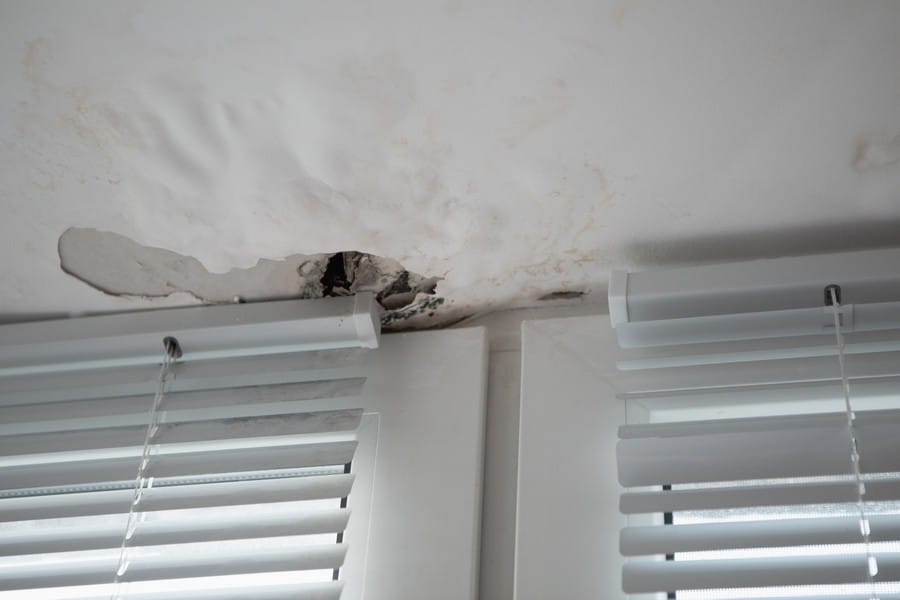Contact Brighton Damp Treatments Now to Speak With an Expert.

Rising damp is a phenomenon of water flowing upwards through porous building material in contact with the ground. It occurs when air drying on the upper surfaces causes the wall to act like a wick, drawing up moisture from below by capillary action and evaporating it into the atmosphere. The process will continue until gravity takes over, unless evaporation remains possible.
Various dissolved nitrates, chlorides and other salts (hygroscopic ground salts) are transported upwards into brickwork and plaster by water flowing from the earth. As this water evaporates, a greater amount of these salts accumulate in the wall.
Ground salts dissolve quickly, meaning they easily absorb moisture from their surroundings.
Rising dampness in walls is often the origin of wood decay in neighbouring timbers. The plaster will thus remain sodden or tainted even once the rising moisture has been treated. Consequently, while treating increasing humidity, it is usually necessary to remove the plaster.

In contrast to penetrating damp which is caused by rain coming in at the top of walls or ceilings, rising damp originates from water that seeps into the ground below. The most successful way to deal with this issue is to install a Damp Proof Course (DPC) that keeps moisture from climbing through floors and walls.
The most common confusion when it comes to damp is mistaking it for condensation effects, a situation where water vapour turns into liquid on contact with colder surfaces. Although the two might look alike, there are certain indications which will indicate that the problem at hand is damp.
The PCA has stated that taking masonry samples, particularly mortar, is a reliable way to determine if increasing dampness is present. Examining the conditions in the wall can demonstrate whether your home is affected by growing moisture. If the samples show signs of water seepage, you have rising dampness. Conversely, if condensation is an issue there will be no evidence of this.

A Damp Proof Course (DPC) should be employed to treat rising dampness, not condensation. Incorrect application will fail to address the problem and any misdiagnosis will result in the wrong solution being used.
Contact Brighton Damp Treatments for a solution to your damp problem. Their experienced professionals have earned an excellent reputation in the industry.
Contact Brighton Damp Treatments Now to Speak With an Expert.
Wind-driven rain can cause penetrating dampness in walls above external ground level, an element out of the property owner’s control depending on the direction of the rain. This may result in moisture migrating lower within the structure.
Wind-driven rain cannot be directed nor its speed regulated, however it can be prevented from entering the building and causing internal harm. Water infiltration may come from cracks in external renderings, missing or loose pointing on walls and window/door frames, substandard flashings surrounding roof structures, or malfunctioning rainwater items including leaking gutters/downpipes and hoppers.
Penetration of damp can result in serious damage to a building if not adequately maintained, including outbreaks of fungal rot (Dry Rot and Wet Rot).
In high humidity times, hygroscopic salts migrate into interior plaster surfaces due to penetrating dampness, leading to the appearance of scattered, isolated patches of moisture.
Signs of moisture intrusion are often easy to spot. Discoloured wallpaper or walls, plaster breakdown and blistering, wet patches on ceilings and concrete surfaces, a musty smell, even mould growth where damp has lingered long – all these can indicate moisture in the property.
Be alert for signs that suggest it may be time to examine your property for potential problems. These could include: increased energy bills, damp patches on walls and ceilings, or cracks in plasterwork.
Ideally, one should inspect their property regularly. Sadly, our world is far from perfect and this rarely occurs due to the demands of everyday life. However, detecting penetrating damp early can save a lot in terms of damage restoration costs in the long run.
Our experienced damp proofers at Brighton Damp Treatments take the initial step of inspecting your home to identify any issues. We will not attempt to deceive you – our only goal is to accurately report and offer practical, cost-effective solutions for any genuine damp problems.
Our damp proofing experts can assess your property, complete a detailed survey and advise on the most suitable repairs. Our surveyors are approved by the PCA (Property Care Association).
Brighton Damp Treatments offers a variety of damp proofing services and is confident that our cost-effective repairs will be backed by 30 year guarantees.
Our damp proofing specialists have the skills and expertise to accurately diagnose any issues in thorough surveys. They’ll provide you with a reliable solution that will bring you peace of mind for years to come, be it rising damp treatment, basement waterproofing, dry rot control or timber treatments.
Our damp proofing specialists can evaluate your property, elaborate a damp survey, and suggest the best course of action for repairs. A damp surveyor must be approved by the PCA (Property Care Association), which is the case with our experts.
Sussex Damp Experts offers a wide range of damp proofing treatments and is confident in our ability to provide cost-effective repairs backed by our 30 years guarantees.
Whether it requires rising damp treatment, basement waterproofing, dry rot control, timber treatments or other damp proofing expertise, you can rely on our damp proofing experts to assess the problems in our detailed surveys and provide you with the most professional services to give you peace of mind for the future.

Call Our Brighton Damp Experts team now for a free quote, consultation and advice.
Minimising rising damp can still allow a small amount of moisture to become trapped in the substrate due to salt contamination. In those cases, PTL will install a chemical DPC system for control purposes. This system is injected into the walls at regular intervals, replacing any salt-contaminated plaster and protecting the decorative surface from any residual wall moisture.
Hygroscopic salts, which absorb water from the ground and are transferred to the brickwork with increased wetness, will continue to draw moisture in high humidity. The damp-proof course prevents further rising of this moisture. If it reaches an unsatisfactory level, re-plastering is necessary – PTL has expert plasterers ready to provide quotes for this job.
Penetrating damp is one of the most hazardous and destructive issues you may encounter in your home. This kind of dampness is also referred to as rain penetration, because it occurs when water from the outside gets into the structure. Generally, water infiltration can be traced back to its source and treated with inexpensive solutions. Our seasoned moisture-proofing experts can evaluate and address penetrating damp problems.
Hundreds of Brighton households have sought our damp-proofing experts. For an assessment or price estimation, please dial 01273 920588 to speak with experienced, qualified professionals.
We use various techniques and solutions to treat and prevent rising damp. Injecting a silicone-based chemical through a series of small holes is one of the most efficient and budget-friendly options.
When it dries, a water-resistant barrier is left inside the wall. Normally, some of the inner plaster contaminated by salts from rising damp must be taken away and exchanged with a salt-proof plaster to enable the moisture in the wall to dry out naturally.
Damp-proofing is a technique to prevent moisture from infiltrating a structure, especially rising damp. Common indicators of rising dampness are ‘tide lines’ of yellowish or brown stains or blown plaster in the lower section of walls above skirting boards. Additionally, skirting boards and floors can decay or become moist.
Carrying out a minor repair to address rising damp, such as repointing or painting over it, may be costly in the longterm and necessitate redoing the work later. Installing a damp proof course (DPC), which is essentially a water-resistant barrier running along both lengthwise and widthwise of your wall, can stop ground moisture from creeping up via capillary action.

At Brighton Damp Treatments, we provide a selection of damp proofing options. Each one provides its own unique benefits. A DPC (damp proof course) helps restrain rising damp by controlling the moisture caused via capillarity.
A Damp Proof Membrane (DPM) is a specialised membrane added to a Damp Proof Course (DPC) in order to repel dampness. It employs silicone material as an effective way of managing moisture, safeguarding buildings from water and rain. Furthermore, it comprises cement such as shotcrete which offers resistance against moisture, water and pressure. Cavity walls create an area between exterior and interior walls to keep out the water while pressure grouting seals any gaps in masonry walls.
A silicone-based solution is injected into a series of holes along the base of a wall affected by rising damp to create a chemical damp-proof course.
Contrary to popular belief, a chemical DPC does not create an impenetrable barrier. Chemical damp-proofing is instead an effective way of filling brick wall pores with water repellent silicone. This lines the pores and reduces the charge attraction of brick particles towards water molecules, reducing adhesive force to one that can be counteracted by cohesive force.

An injector is utilised to instil the silicone-based damp-proofing cream into twelve millimetre holes drilled into the bed joint. The damp-proof course responds quickly before curing, forming a water repellent shield that aids in combatting rising dampness in brick and masonry walls.
The most essential element in dealing with rising damp is the injection method. It’s highly effective and easy to apply, proving a reliable solution.
Water will still ascend the perp-end joints even if a chemical damp proof course system is installed in bricks or blocks along a stretch of brickwork. A continuous path is required for water to climb a wall, hence the only layer that can act as an effective moisture barrier is the mortar bed joint.
Beneath the floor joists on the inside, or close to it where it is solid, a DPC (Damp-Proof Course) should be installed at least 150mm above the external ground level. Where these two are not compatible, further measures may need to be taken in order to protect lower lying areas and flooring timbers.
To prevent horizontal moisture flow from neighbouring walls, a vertical upstand must be installed if the wall surpasses the new DPC, such as an extended terrace. Injecting chemical into holes in a zigzag pattern along the mortar line of the wall to at least 1 metre will create a vertical DPC.
Injecting cream from both sides of the wall is recommended for cavity walls made of brickwork. In rubble-filled walls, damp proofing chemicals will probably not be effective; instead, an electro-osmotic system is likely to yield better results.
If you detect moisture in your home, act promptly to prevent potential problems for the inhabitants.
The visual distress caused by dampness can be severe, and if not treated promptly it can cause significant structural damage to a property. There is also evidence that exposure to damp conditions may worsen respiratory issues in those who suffer from them already.
If you’re experiencing damp due to condensation, leaking gutters or pipes, contact our experts in damp removal and proofing without delay. We’ll get it sorted promptly.
We have devoted ourselves to delivering top-notch service and extensive expertise, enabling us to remain successful.
The size and style of the property, the cause of dampness, the materials involved – all these factors influence how much it will cost to rectify a damp problem.
Don’t delay; contact our highly skilled team to arrange a survey and have one of our amiable staff assess the property in order to give you the most economical quote and solution.
We excel in providing damp proofing treatments, re-plastering services, wood preservation and carry out damp surveys with expertise.
We offer customised, reliable and proficient damp proofing treatment and repair services to homes, local authorities, small companies and large commercial properties.
Ring us now on 01273 920588 to talk with one of our friendly staff about your requirements.
For your safety and assurance, our work is fully insured by our company guarantee. Additionally, we are part of the Guarantee Protection Scheme, offering an independent insurance policy that covers the duration of any guarantee you may choose to purchase.


Max and his team have been at our property all week and I really can’t thank them enough for the fantastic job they’ve done on plastering both our walls and ceilings. They have literally transformed the appearance of our house! Not only has Ma…
From start to finish Max has been incredable. His knowledge lin damp proofing is second to none and his team where very clean and polite. The plastered finish was like glass so happy we choose Max Plastering for job.
Lovely bunch of lads left a very neat and clean job. Problem was solved.
Perfect Finnish and all left clean and tidy and no mess. Used Max previously and would not hesitate to ask him carry out more work.
Max, Harvey and Stuart arrived promptly as arranged. Done a great job on our outside rear wall. Work completed to a high standard, removal of all old material and cleaned up after themselves. I am so pleased with the standard of their work they ar…
They turned up on time and carried out the works in a very professional manor leaving the front of the house clean and tidy. Very impressed would definitely recommend.
I have to say that on every level Max (with Stuart and Harvey) did an extremely professional job! They explained what they were going to do, they were polite and courteous and respected that they were coming into our home. The plastering is of the…
I called max and he managed to come around the same day to do a survey. The next day I received an extremely detailed survey compared to any other damp proofer which made me feel very at ease that he was going to do the right job. Max and team tur…
Contact Brighton Damp Treatments Now to Speak With an Expert.